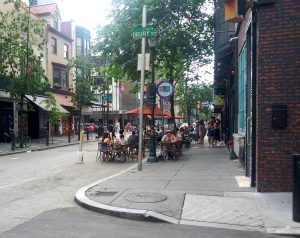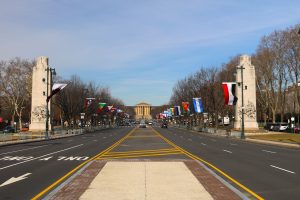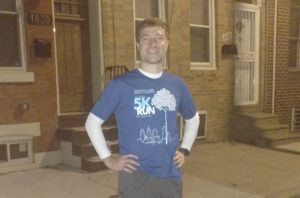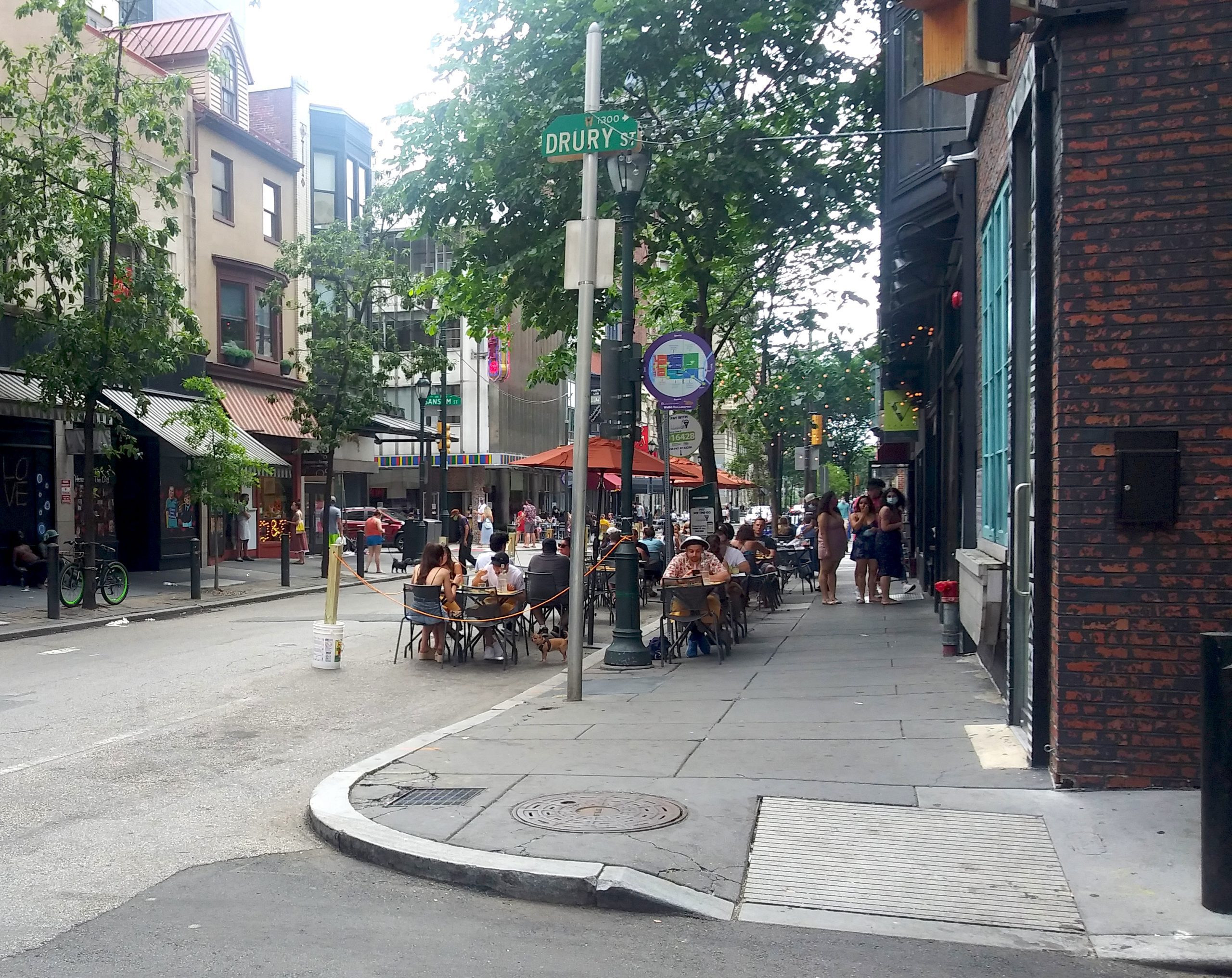

(JUNE 25, 2020 – PHILADELPHIA, PA) — Clean Air Council and Feet First Philly applaud City Council for passing bills 200351 and 200352. Expanding outdoor dining for Philly’s restaurants and permitting right of way closures including street parking is key to preventing the spread of COVID19 while businesses begin to open.
Both bills are extremely important. However, we strongly support bill 200352, permitting right of way closures. Without this bill, restaurants and businesses wouldn’t have access to extra space to ensure customers and pedestrians are able to maintain safe social distancing. Converting parking spaces and permitting expanded use of the parking lane will allow safe passage for pedestrians and ample room for outdoor seating.
Clean Air Council and Feet First Philly support these bills and other measures to use public space effectively to aid in the safe reopening of the region’s businesses. Read more about our Recovery Streets platform put together with 5th Square and the Bicycle Coalition of Greater Philadelphia.
We are aware that the city’s hospitality industry suffered tremendously from closures due to the public health emergency. Clean Air Council and Feet First Philly applaud the creative efforts restaurants have utilized to ensure that people are able to safely walk up to establishments they wish to patronize. We hope that the City of Philadelphia continues to match this creativity, and adopt new measures to rethink how our public space is used to benefit everyone.
Jennifer Dougherty, Chair of Feet First Philly – “These bills support both the economic and personal health of Philadelphians. Now is the time to reimagine our street space to allow for a healthier, more vibrant, and safer Philadelphia today and in the future.”
Joseph Otis Minott, Executive Director and Chief Counsel of Clean Air Council – “Allowing expanded outdoor dining is key to helping Philly’s diverse restaurant scene survive during the public health emergency. Bill 200352 is a big step in the right direction for better use of the city’s public space. These bills ensure that restaurants can use the public right of way to keep their staff and diners safe as the city begins to reopen.”
CONTACT: Ptah Gabrie pgabrie@cleanair.org 215-567-4004 x 127 for more information

Clean Air Council, Feet First Philly, 5th Square, and the Bicycle Coalition unveiled a Recovery Streets platform to serve as a roadmap to safely transform street space in Philadelphia during and as we recover from COVID19.
This plan gives a menu of options for the types of solutions that the city should implement in the months ahead. While we applaud the City for its initial move to close MLK Drive to vehicle traffic, there has been little progress toward creating areas where people can safely be outside, or to address concerns regarding pedestrian safety along routes to essential businesses. These solutions will be increasingly more important as we start to recover from the COVID19 pandemic.
As businesses reopen, if these measures aren’t put into place Philadelphia will suffer worse congestion and gridlock than pre-COVID, and damages to air quality, road safety, and equity will be greater than before.
States are beginning to ease stay at home orders, and people are eager to be outside for necessity during the hot summer months, but they need to be able to do so safely. Unfortunately, pedestrian fatalities are nearly 88 percent higher in 2020 than this time last year. That is why now is the right time for Philadelphia to invest in its residents and implement measures that reduce crashes and keep pedestrians out of harm’s way.
Philadelphia’s COVID19 recovery is a chance for the City to be a leader in this space and move toward the Mayor’s Vision Zero Goals. Please take the time to read our Recovery Streets platform to learn how we believe the City of Philadelphia can be a leader in COVID19 recovery. Click here to read our full platform then sign our petition in support.
PHILADELPHIA, PA (June 4, 2018)- Clean Air Council joined other advocates testifying at City Council in support of the proposed changes to Spruce and Pine Streets in Center City. The project would include protecting intersections and moving the bike lane to the left side of the road where there is a smaller blind spot for drivers. These changes would increase safety and make non-motorized travel along these streets more comfortable and enjoyable. Read the Council’s testimony below to understand why it supports the proposal now, and what it would like to see in the future.
Thank you for the opportunity to present testimony on behalf of Clean Air Council today. My name is Nick Zuwiala-Rogers and I am the Transportation Program Director at Clean Air Council. My work includes promoting sustainable modes of transportation like public transit, walking, and cycling.
Clean Air Council is one of the Philadelphia region’s oldest environmental organizations, serves thousands of members in the city, and has a mission to protect everyone’s right to breathe clean air. The Council supports the proposed project on Spruce and Pine and the associated bills to change parking along these roads, and believes it will help improve air quality in Philadelphia.
According to the U.S. Energy and Information Administration (EIA), the transportation sector has produced more carbon pollution than any other sector since 1979. The EIA has cited the country’s over reliance on single-occupancy vehicle travel and a failure to prioritize non-driving modes of transportation as having a profound impact on this result. Philadelphia needs to do better at prioritizing other modes of transportation like walking, public transportation, and bicycling, and this project offers an opportunity to do that.
Due to the congestion that this City Council has noted recently, center city has some of the worst localized air quality in the city. Therefore, increasing the number of people getting around without using a car should be a priority for this Council. Increasing the safety and comfort of cyclists and pedestrians is the only way to make that happen.
Protected bike lanes are a proven solution for making all road users safer, and getting more people comfortable biking, thereby increasing mode share away from congestion-creating automobiles downtown. A Federal Highway Administration study found 96% of cyclists feel safer riding in a protected bike lane, and safety for cyclists and vehicles improved in nearly every aspect where flex posts or parking protected bike lanes were installed. A physical separation reduces traffic speeds, calms intersections by reducing the turning radius and forcing slower speeds, and creates a shorter crossing distance for pedestrians. I understand that is not what is proposed today, but I should be clear that physical protected bike lanes are ultimately what the Clean Air Council supports.
While this project does not go as far as creating the protected bike lanes that should eventually be installed on these roads, the protections at intersections and the move from right to left side of the street offer key incremental changes that will make road users safer on Pine and Spruce Streets. Importantly, the protected intersections that are a part of this project would help to prevent crashes like the two last year that ended fatally for one person, and with nearly the same result for another. The move to the left side of the road will decrease the space that a cyclist is in a vehicle’s blind spot, especially trucks which are so deadly.
These two roads are the main arterials across center city for cyclists, and are two of the most used bike lanes in the city. The current design is frankly way behind the times and way behind where a city like Philadelphia needs to be with its infrastructure. These safety improvements are not just needed, they are long overdue, and Clean Air Council strongly urges you to support the proposed bills in front of you today.
Thank you for the opportunity to speak with you this afternoon, I’d be happy to take any questions now or discuss any of these matters more with you outside of this meeting.

Time is ticking down. The Philadelphia Marathon, which will be my first (maybe last?) attempt at running 26.2 miles, is right around the corner. As the Council’s Transportation Program Director, I have always taken a lot of pride in how closely my passion for cycling aligns with my job. Obviously living in Philadelphia I also love to walk to my closer destinations and mix in public transit when I’m going a bit further. So I felt like I had a responsibility to at least give this running thing a shot, to round out the low/zero emission ways that people move around (I already tried skateboarding as a kid, I guess roller skates are all that is left).
Because running is sustainable transportation, and because the only experience I have with running is volunteering at the Council’s annual Run for Clean Air in April (April 9th, 2017 – save the date now!) I felt it only natural to run the marathon on behalf of the Run for Clean Air. Coming from a cycling background, I am pretty confident in my cardiovascular preparation for the event, but I now have a much deeper respect for the strength that running requires from your legs’ joints, bones, and muscles. Building up to that without injuring myself has been the priority of my training.
Another priority has been immersing myself in a completely new activity. I want to thank my fellow runners and my running group, Point Breeze Runners, for showing me the ropes. Of course, I’ve been reading up on running blogs and tips for first-time marathoners like crazy, but I’ve also been getting a crash course in how to behave appropriately on the sidewalk or trail while I’m running. How much room to give people when passing, how to run in a group, how to interact with cars safely, and I’ve been getting some of it wrong along the way – but I’m trying! Respecting all road users is a priority for me as I learn how this large group of people, runners, interacts with our city infrastructure.
Training has gone well for the most part. I’ve gradually extended my distance up to 20 miles without any bad injuries, but unfortunately on that run about a month ago I did irritate something in my hip. I’m pretty optimistic about it though, it has given me the perfect opportunity to scale back my running so I am nice and fresh on race day. I also have a secret weapon – Eric Cheung, the Council’s Deputy Director has promised to meet me at mile 20 and run the last 6 miles back into town with me. Thanks for the support Eric! If any Clean Air Council members are watching on race day, be sure to give me/us a cheer. I’ll be the one in a Run for Clean Air shirt looking like he doesn’t belong but having a great time.

Cities across the world are finding success in combating poor air quality, climate change and their related health impacts with car-free days. Last year, Paris went as far as to ban vehicles in 30% of their city. As a result, nitrogen dioxide, a harmful air pollutant, dropped by 40% in parts of the city. On Butler Street in Pittsburgh, air pollution registered four times lower during their car-free event called OpenStreetsPGH. This year, on September 24th, Philadelphia will be partaking in its first designated car-free event, known as Philly Free Streets. So, what exactly is a car-free day, how will it look in Philadelphia and what are the other benefits? We’ll let the folks at Open Streets PHL, a nonprofit behind the local movement for open streets, explain:
What if we opened our streets to people for walking, cycling, playing and socializing by simply closing them off to cars for a few hours?
It’s called Open Streets and it’s a way to bring life and energy back to Philadelphia’s most underutilized public space — our city streets.
Open Streets initiatives temporarily close streets to automobiles so that people may use them for healthy and fun physical activities. Today, there are more than 100 Open Streets initiatives in the United States and Canada alone.
Many North American Open Streets organizers originally drew inspiration from Central and South American cities, where these initiatives are often called “Ciclovía.” The word Ciclovía literally translates to “bike path,” and was coined in Bogotá, Colombia when the city introduced the program in 1974. With nearly 70 miles of streets open for non-motorized activity each Sunday and holiday and 1 million participants on a weekly basis, Bogotá is an admirable leader of this growing global movement.
Open streets programs are increasingly popular because their goals align with the challenges that cities and towns face related to public health, economic growth, and the environment. Every open streets program follows the same principles: encourage physical activity; allow participants to reimagine their communities as places to walk and bike for transportation; improve air quality by removing cars from the road; and encourage people to frequent businesses and fuel local economies.
Philadelphia’s Open Streets movement grew out of the city’s experience with Pope Francis’s visit in September 2015. As part of the security preparations, the city closed down streets all throughout Center City and some of the surrounding neighborhoods.. Though the street closures created a disruption that negatively impacted many residents and business owners, many people also realized how much they enjoyed our public streets in the absence of motor vehicles.
Parents played in the street with their children; men and women ran, cycled, and walked along corridors typically clogged with cars; and people of all ages came out to enjoy a space both familiar and brand new. Philadelphia residents were energized by the feeling of freedom that comes with open streets.
The advocacy group Open Streets PHL formed in the wake of the Pope’s visit with the aim of creating an open streets program in Philadelphia. We worked closely with City transportation staff to refine the concept, and to provide them with a playbook that served as a how-to guide for hosting these events.
Thanks to the advocacy of Open Streets PHL, the city of Philadelphia will host its first Open Streets event, called Philly Free Streets, on Saturday, September 24th, 2016 from 8:00 AM to 1:00 PM, exactly one year after Pope Francis’ visit.
How Philadelphians decide the use 7 miles of open streets on the 24th is anyone’s guess, but we do have a pretty good idea of what some of the benefits will be.
They’ll get exercise — in other cities, over 90% of participants meet their recommended daily physical activity and nearly 40% get the recommended weekly activity in just a single day. They’ll also connect with the community– 25% of participants in Fort Collins, CO said they attended to strengthen community ties and nearly 90% in St. Louis, MO said they had a more positive view of their city after attending Open Streets.
We also know from open streets programs in other cities that businesses along the route benefit tremendously from all the foot traffic during the event, and from all the additional eyes on their storefronts. In San Diego, CA over 80% of participants shopped or ate at stores along the route and also said they planned to make return visits. St. Louis reported similar outcomes, with over 80% of participants spending some money, and nearly 70% becoming aware of a new store or restaurant they hadn’t seen previously.
We’re expecting similarly positive results from the first Philly Free Streets program in September. This inaugural event will transform the streets from Front & South to the Schuylkill River Trail and Dr. Martin Luther King, Jr. Drive, all the way up to Parkside and West Fairmount Park.
The city team planning Philly Free Streets, led by the Mayor’s Office of Transportation and Infrastructure Systems, has announced that the 7+ mile route will include free, family-friendly fitness activities, as well as educational programming about the City’s waterways, public art, architecture, environment, and cultural resources.
A route map for the September 24th Philly Free Streets program and the Open Streets PHL playbook can be found at http://openstreetsphl.com.
Authored by: LeeAnne Mullins and the Open Streets PHL team

